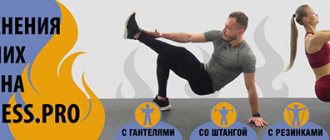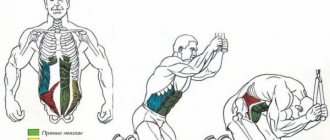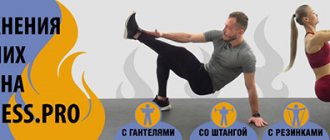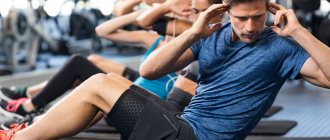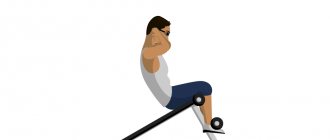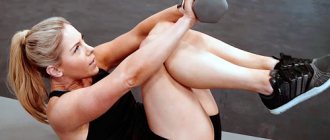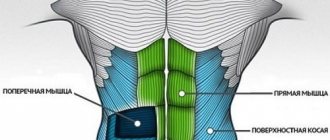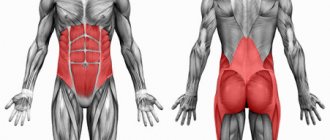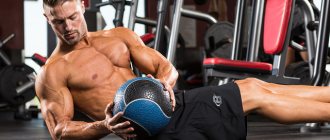Share:
Ab crunches are an exercise performed by athletes to gain strong and sculpted abs. According to its biomechanics, it represents an elevation of the torso with a slight rounding of the back (kyphosis) in the thoracic region from a lying position. As a rule, crunches are not performed by the athlete in the maximum possible amplitude, so that the load is constant and the abdominal muscles do not relax at the top and bottom points. Working in a similar technique, the load is focused on the upper part of the rectus abdominis muscle.
This exercise has gained well-deserved popularity among athletes involved in crossfit, bodybuilding, fitness and martial arts, since a well-developed abdominal press plays an important role in all these disciplines. And today we will tell you how to do crunches correctly - all possible variations of this exercise.
Insufficient weighting
Many people believe that to train their abs, it is enough to do high-repetition crunches without weights. They lie down on an incline bench and begin to do crunches 20-30 times, if not a good hundred.
Now imagine that you pick up an 8-kilogram dumbbell and do about 30 repetitions for the biceps. Not sure that such training tactics will lead to muscle hypertrophy? The same is true for abdominal exercises without weights.
Cable crunches: a good example of a weighted exercise
For abdominal hypertrophy, they need to be given additional load - that is, work with weights. There are many options. Perform crunches with weights (for example, with a weight plate or dumbbells in your hands), crunches on a block or in a machine with no more than 12 repetitions per set.
And most importantly, it is important for you to progress in weights and not stop there. This is the only way your abdominals will really grow and take on a defined shape.
The exception to the rule is beginners. If you are in the gym for the first months, abdominal exercises without weights can also give results. Moreover, at the initial stage they are the only ones worth doing to avoid the risk of injury. And only when you have been following your usual program for at least 2-3 months, can you switch to weights.
How to determine your working weight? Everything is very simple.
Set the weight on the machine or on blocks, and then do 12 repetitions. If you work as hard as you can on the last rep, the weight is correct. If not, you need a supplement.
Ab crunches: technique of execution
The technique for doing abdominal crunches can vary depending on the type of exercise. First, let's look at the classic version. Proper technique is very important for him, as it increases the effectiveness of the exercise and prevents possible injuries. Classic straight abdominal crunches are the easiest, and beginners should master them first, and only then proceed to other variations of the exercise.
They are performed as follows:
- Lie down on the floor.
- Press your lower back to the surface.
- Your legs need to be bent at the knees so that there is a right angle between the thigh and shin. Place your feet on the floor.
- Your hands can be placed behind the back of your head, folded across your chest, or extended in front of you.
- Next, lift your torso, tensing your abdominal muscles. Only the shoulders should come off the floor surface, and the lower back should be pressed against it.
Throughout the entire approach, keep your abdominal muscles toned and do not relax them.
This way you can achieve maximum efficiency. Now repeat the exercise as many times as necessary. Also, when asking how to do abdominal crunches, consider the following points:
- When lifting, you should round your back rather than lift your entire torso.
- The feet should be firmly planted on the floor and not leave it.
- At the highest point, hold for a second and inhale as you lower. The muscles should remain tense.
Incorrect timing
The abdominal muscles make up part of the core muscles responsible for the stable position of the spine, pelvis and hips. They participate in many exercises, including basic exercises such as deadlifts and squats.
For this reason, your abdominals should be “fresh” when you begin these exercises. So it’s best to do abdominal exercises towards the end of your workout, or at least after the basic ones. Otherwise, you will have poor weight control, which can result in injury.
What muscles work during crunches?
The good thing about crunches is that it forces all areas of the abs to work at the same time. The only difference is which area will receive primary load and which will receive secondary load.
Therefore, in order to reap maximum benefits and train your abs evenly, it is necessary to perform different variations.
During classic crunches, the rectus abdominis muscle takes the main load. It is she who is responsible for creating “packs” - the main goal of many athletes. The entire muscular corset of the abdominal area is also strengthened. The stronger the press, the better it stabilizes your body, and the better your posture becomes.
Depending on the type, the emphasis of the load falls on the rectus, oblique or transverse abdominal muscles. In addition, others can also participate in the work: for example, when performing a technique on a simulator, the hips are included in the work.
Despite this, the press will still take the main load. The participation of the rest will be so insignificant that it can be neglected.
Monotonous program
Incline crunches are the most popular exercise, which many consider to be the most effective (although this is not at all true). As a result, most build their abdominal training program solely on this exercise. Muscles quickly adapt to the same type of training and stop responding to the load.
Our advice is not to focus on crunches, but to include other abdominal exercises in your workout. It would be great if all of them could be performed with weights.
Set of exercises “Turns”
Exercises that involve moving weight in your hands cause a change in the center of gravity. This is usually not emphasized, however, when performing power movements, we actually do not just raise and lower the barbell, but direct all our efforts to maintain balance.
Let us consider from this point of view the well-known standing biceps curls. Only people ignorant of bodybuilding can believe that the weight of the weight depends entirely on how developed the arm muscles are. But, as it turns out, the weight of your weight depends on the fitness of your abs, because it is the one that maintains the balance of the body during the exercise.
Do not forget that the abdominal muscles perform work in three planes:
- sagittal movements - direct abduction and extension of the body and legs;
- frontal - lateral tilts of the body;
- rotation of the body.
From the first training, train your core muscles to work harmoniously as a team. This will allow you to achieve better results in training other muscle groups. To properly develop your abdominal muscles, you will need a training program consisting of three types of movements. Three sets performed without rest are even better for this.
Once you have good abs, you will feel how much easier other exercises become. By comparing the difference before and after abdominal muscle training, you will understand how much you were mistaken before when you thought that abs were only needed for aesthetics.
To perform the exercise, you need to hang on the bar, bend your knees at an angle of 90 degrees. Slowly bending your knees to the side, lift your feet as high as possible. At the top phase of the exercise, a static pause is made. The next exercise is performed on the opposite side.
To take the starting position, stand sideways to the upper block, place your feet shoulder-width apart. Balance your stance with your knees slightly bent.
Holding the handle of the block with both hands, align the body in a strictly vertical position. The movement should be performed along an arc path: with straight arms, lower the handle down, simulating a chopping movement. At this moment, the body must rotate around its axis. Return to the starting position smoothly, without jerking. It is very important that during this exercise the range of motion is maximum.
V-turns
This exercise is performed on the floor. You need to lie face up and straighten your legs. While simultaneously raising your straight legs and body, extend your arms towards your feet. Stay in this position and turn your body as far as possible to one side. Hands should follow the body without changing position. Make a similar movement in the opposite direction.
Bike
Starting position: lying on the floor, clasp your hands behind your head and slightly raise your extended legs. Perform a simultaneous twist and pull of the knee towards the chest. While twisting, try to touch the knee raised to your chest with your opposite elbow. Return to the starting position, and then repeat the same movement, but for the other knee and elbow.
Twist tackles
Swiss ball tackles with a turn are performed like regular tackles, with the exception that when rolling the ball, you must turn your knees to the side. The range of motion of the knees should be maximum. Turns should be done alternately for each side.
The exercise is performed on the floor, lying on your back. For convenience, stretch your arms along your body and rest your palms on the floor. Raise your straight legs perpendicular to the floor, and then slowly lower them to the side, performing a static pause at the end. Return to the starting position and do the same for the other side.
Take the starting position: lie on the floor face up, bend your knees, stretch the weight on your straight arms in front of your chest. Tightening your abdominal muscles, lift your shoulder girdle up. During the exercise, the lower back should not lose contact with the floor. When lifting, first turn your body to one side without bending your arms.
Samson Tilts
This exercise bears the name of its author, the strongman Samson. To perform, you need to stand straight, holding dumbbells above your head with straight arms. Your feet should be shoulder-width apart. Bend your body sideways as low as possible, keeping your arms and body in the same line. Returning to the starting position, repeat the exercise with an inclination in the opposite direction.
To perform the exercise, you need to stand straight with your feet shoulder-width apart. The dumbbell is held in a straight hand at the hip. The second arm is straightened along the body. Bend slowly towards the dumbbell, bending as low as possible. Just as slowly you should return to the starting position. After completing a number of repetitions, transfer the dumbbell to the other hand and begin bending in the other direction.
Exercise "board"
In order to take the starting position, you need to lie on your side, leaning on your bent arm. The second hand rests on the side. The legs are straightened, one lies on top of the other.
Slowly lift your pelvis up, straightening your body in one line. You need to hold this position for as long as possible. Repeat the exercise, changing sides.
To perform the exercise you need to lie on your side. The head rests on the bent arm, the other arm rests in front of you on the floor to stabilize the body. Legs should be straight.
Raise your top leg as high as possible, keeping your leg straight and in the same plane as your body. In the upper phase of the rise, a static pause is made. After completing the required number of repetitions with one leg, change your body position and switch legs.
Tilts on the block
To perform the exercise, stand sideways to the lower block. Grasp the handle with the hand closest to the block. Straighten your back and then bend in the opposite direction. At the maximum point of inclination there is a static pause. Slowly straighten up. Having completed the required number of bends in one direction, change position and begin bending in the other direction.
Side twists
To take the starting position, you need to lie on the floor, turning on your side. One hand rests on the floor with a bent elbow, the other is placed behind the head. To stabilize your position, put your legs together and bend them at the knees, moving them slightly forward.
Raise your shoulder girdle as high as possible in the longitudinal projection. Having completed the necessary twists on one side, do the same on the other.
Side leg raises
Take the starting position: to do this, you need to lie on your side, place one hand behind your head, and rest your elbow on the floor with the other.
Raise your straightened legs as high as possible, the movement is carried out in the longitudinal plane of the body. At the top point of the movement, fix the position, and then smoothly lower your legs down. After completing the desired number of lifts, change legs.
Focus on the upper abdominals
Many people neglect lower abdominal exercises and focus only on those that work only the upper part. There is no harm in this, but such a training scheme will also affect the appearance of the abdominal muscles.
The solution to the problem is quite simple - include reverse crunches in your training, as well as hanging leg raises or in a machine. All these exercises work perfectly on the lower abdominal muscles.
In addition to the lower abdominal muscles, the oblique muscles or the internal abdominal muscle may be out of work, which, by the way, helps it not to fall out. To keep these muscle groups from falling behind, perform side crunches and the vacuum exercise.
Ab crunches: features and benefits
The ab crunch exercise is similar to, but different from, regular sit-ups. The amplitude is not so important here, and it is not at all necessary to raise the body to a right angle. Continuous muscle activity is more important, as is movement control. To do this, you can slightly round your back in the thoracic region. This is completely acceptable and does not increase the risk of injury.
The good thing about crunching exercises is that by choosing one type or another, you can diversify your workout and target a specific area of the abs. They also have a beneficial effect on the condition of the spine and posture.
The exercise itself is quite simple. While performing it, you will feel the stretching and contraction of the abs, which indicates the effectiveness of twisting. You can do them anywhere and anytime, without using simulators or additional equipment. By devoting just 10-15 minutes , you can fully work out your abdominal muscles. It is only important to know how to do crunches correctly.
Passion for athletic belts
An athletic belt is a great tool to help stabilize your core and lift heavy weights, but you shouldn't get too carried away with it. During exercises with a belt, your abdominal muscles do not work at full strength, and you may be unpleasantly surprised when you perform your usual exercises without a belt. If you can do them at all!
Keep your abdominal muscles toned by performing basic exercises without a belt. If you can't do this with your usual weight, lose it by a few percent. Your task is to keep your core muscles strong and not give them any slack.
Common Mistakes
The most common mistake when performing this exercise, which is made by almost everyone who begins to master it, is performing sit-ups instead of crunches.
If, when twisting, the body seems to be hunched over, and the body approaches the groin, then during lifting of the body, the back remains straight, and the shoulders move towards the knees.
With this technique, anything will work, but not the press. You can do twisting in this manner for months and even years, but still not get the desired result.
Remember also about the measured pace of the exercise. The faster you do it, the less efficiently the necessary fibers will be included. In addition, it is necessary to avoid the appearance of inertia in order to go through every centimeter of the amplitude of movement due to high-quality tension of the abdominal muscles.
Also, when performing this exercise, many people strain their neck and press their chin to their chest. This should not be done - it is an extra burden that is best avoided.
In addition, improper breathing is a big problem for many. At the moment of twisting the body, you need to exhale sharply and truly powerfully; in this case, the load on the rectus abdominis muscle will be maximum. Don't be afraid to breathe loudly, even if you're working out at the gym - this will make your abs workout really effective.
Relaxation of the abdominal muscles at the peak of the extension movement is also common. If you keep your muscles tense throughout the entire amplitude, the effectiveness of the exercise will double.
Frankly speaking, it is best to perform exercises with weighted abdominal muscles only when you can already calmly raise your toes to the bar while hanging. This is not just a quibble, but a criterion for assessing strength. It is at this level that a person can stabilize the lower back and perform the exercise precisely by contracting the rectus abdominis muscle, and not by swinging, inertia and “bringing” the legs. Should you wear weights on your arms while working out your abs? There is no single answer to this question. And the point of view about preliminary development of strength and balance is also not very popular in the fitness world. And this has a fairly simple rationale.
Summary
If you really want a 6-pack, we recommend skipping high-rep training in favor of strength training with weights and low reps. This tactic will help achieve pronounced hypertrophy, which will be easy to notice at a body fat percentage below 9.
Also, a big plus for your abdominal muscles will be a variety of training, inclusion of basic exercises in the program and a proper rest regime.
abdominalbugspress
Lying straight leg raises
Raising your legs while lying down is very useful if you have insufficient lumbar lordosis. And, on the contrary, refuse this exercise if your lumbar lordosis is too pronounced, and during the exercise you feel tension in the lower back.
Lying straight leg raises. Start.
Execution: Lie on the mat with your feet together. Raise your head off the floor and bend your elbows as shown in the photo. If it is difficult to hold your head, place your hands behind your head and support it with your palms.
Smoothly raise and lower your straight legs, lightly touching your heels to the floor. When raising your legs, exhale, when lowering, inhale.
Once again, I note that the exercise is performed smoothly - 3 sets of 12-25 repetitions.
Plank
This is the most famous static abdominal exercise. By the way, the bar trains not only the abdominal muscles, but also many other muscles of the whole body. The plank perfectly develops endurance and perfectly dries the body (gets rid of extra pounds).
Front bar
Execution: Get on all fours, and then take a plank position, standing on your elbows.
It is necessary to hold in this position for 30 seconds or more. Typically no more than 2 minutes is recommended.
Keep your body straight and pay attention to the sensations in your lower back. If tension appears in the plank while doing the plank, stop doing the plank for a while. You first need correction of lumbar lordosis.
The plank can be performed in 3 approaches of 30-120 seconds.
DESCRIPTION
- Lie on your back with your feet flat on the floor or on a bench and your knees bent at a 90-degree angle.
- Keep the weight on your chest, or you can hold it with straight arms above your torso. This is your starting position.
- Now, as you exhale, slowly begin to lift your shoulders off the floor. Your shoulders rise from the floor to a height of about 10 centimeters while your lower back remains on the floor.
- At the top of the movement, tighten your abdominal muscles and hold for a short pause.
- Then inhale and slowly lower yourself down to the starting position.
Contraindications for implementation
The exercise itself is safe; even with problems in the lumbar region, twisting is not prohibited. But there are contraindications to performing the exercise in case of diseases and inflammatory processes in internal organs, recent operations, injuries, chronic and infectious diseases. It is also forbidden for pregnant girls to curl, and even for gynecological diseases.
To some extent, the exercise can be called dangerous. When the body lies on the floor, the vertebrae are pressed against each other, compressing the intervertebral discs. This way they fix the spine and prevent the abdominal muscles from bending. This causes static tension in the abdominal area, although the muscles do not contract.
Excessive pressure on the vertebrae is a problem that can become critical for some people. Therefore, the exercise is not recommended for those who have back problems and those who are constantly engaged in sedentary work.
But even in this case, you can perform the technique without harm to your health. To do this, you just need to place a cushion under your back: the lower back will take the correct position, which will reduce the load on the spinal discs. In addition, it will be possible to achieve a natural curve of the spine, which is maintained in an upright position. Additionally, you can perform exercises with greater amplitude, which means giving your abdominal muscles greater stretch and contraction.
Benefits of exercise
A large number of exercises aimed at working the abdominal muscles allows each athlete to choose a set of exercises for themselves. Some of them are more effective for the abdominal muscles, while others load it much worse. One of the exercises that works well on the abdominal muscles is weighted crunches.
Crunches performed with weights are considered one of the most effective ways to pump up your abs. During this exercise, the rectus abdominal muscle actively works. Due to the weight placed behind the head on outstretched arms, the abs are stretched more strongly, which helps to better work the muscles.
- Beginning athletes often chase sporting success. To do this, they lift heavy weights and try to do as many repetitions as possible. This should not be done under any circumstances, since you will not be able to achieve anything other than injuries. It is better to train steadily with light weights than to suffer after trying to lift a heavy dumbbell.
- Also, during crunches, beginners constantly open their legs from the floor, trying to help themselves rise. This significantly reduces the load on the abdominal muscles, so such training becomes ineffective. It's better to ask your partner to hold your feet. This way they will stand level on the floor and the press will work well. If there is no friend in the gym, then you can hook your feet to the bottom bar of the wall bars.
- It is important to remember that proper crunches are always performed with a rounded back. If you hold it straight, then instead of the abdominal muscles, the lower back will be activated, and heavy weight can negatively affect its condition.
- When doing weighted crunches, you should never take a long pause before doing a new repetition. During this short time, the abdominal press has time to relax, so the workout is not as effective as we would like.
- Beginning athletes should know that the development of the abs depends on the quality of twisting. If you twist too weakly, the press will not be able to work properly. However, frequent use of pullover crunches allows you to build good abs in a short time. This is facilitated by the fact that the exercise can be easily performed at home. The main thing is to have dumbbells or an expander at home.
Press crunch training on the floor can be very effective, but before you start exercising, it is recommended to study possible contraindications. These include herniated intervertebral discs (in certain cases), osteoporosis and late stages of osteochondrosis, pregnancy. But there are exceptions to any rule, so it makes sense to consult a specialist.
If other types of loads are performed, it is necessary to clearly assess whether a given muscle group is involved in these loads so that there is no effect of superimposing loads.
Fitness, football, running, swimming - each of them will require the results that this exercise gives:
- Strengthening the abdominal press - everything is simple here, the stronger your abs, the greater the load you can subject it to, and the more effective the result from subsequent training.
- Strengthening your core muscles - they keep your body straight when you stand. By strengthening them, you will be able to better control your body.
- Increasing your body's stability and stability is an especially important factor when performing compound exercises such as deadlifts and squats.
- Improved posture – no one likes to look at people hunched over.
- Working out different muscle groups - the load can go to the rectus, oblique or transverse abdominal muscles.
- No additional equipment is required to perform - crunches can be performed at home, in the gym and even on the street.
Quite a long list for such a simple exercise, isn't it?
The main advantage of the exercise that sets it apart from others is its safety. The fact is that when twisting, the abdominal muscles contract as much as possible without putting stress on the spine or other joints. Perhaps this is the safest, technically simplest and most understandable exercise. There are more complex versions of the exercise, but they should be performed by trained athletes.
This exercise strengthens the rectus abdominis muscle, which is a spinal stabilizer muscle.
Another benefit is improved blood circulation in the abdominal cavity and massage of internal organs.

